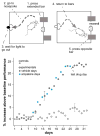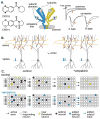The likelihood of cognitive enhancement
- PMID: 21215768
- PMCID: PMC3114293
- DOI: 10.1016/j.pbb.2010.12.024
The likelihood of cognitive enhancement
Abstract
Whether drugs that enhance cognition in healthy individuals will appear in the near future has become a topic of considerable interest. We address this possibility using a three variable system (psychological effect, neurobiological mechanism, and efficiency vs. capabilities) for classifying candidates. Ritalin and modafinil, two currently available compounds, operate on primary psychological states that in turn affect cognitive operations (attention and memory), but there is little evidence that these effects translate into improvements in complex cognitive processing. A second category of potential enhancers includes agents that improve memory encoding, generally without large changes in primary psychological states. Unfortunately, there is little information on how these compounds affect cognitive performance in standard psychological tests. Recent experiments have identified a number of sites at which memory drugs could, in principle, manipulate the cell biological systems underlying the learning-related long-term potentiation (LTP) effect; this may explain the remarkable diversity of memory promoting compounds. Indeed, many of these agents are known to have positive effects on LTP. A possible third category of enhancement drugs directed specifically at integrated cognitive operations is nearly empty. From a neurobiological perspective, two plausible candidate classes have emerged that both target the fast excitatory transmission responsible for communication within cortical networks. One acts on nicotinic receptors (alpha7 and alpha4) that regulate release of the neurotransmitter glutamate while the other ('ampakines') allosterically modulates the glutamate receptors mediating the post-synaptic response (EPSCs). Brain imaging in primates has shown that ampakines expand cortical networks engaged by a complex task; coupled with behavioral data, these findings provide evidence for the possibility of generating new cognitive capabilities. Finally, we suggest that continuing advances in behavioral sciences provide new opportunities for translational work, and that discussions of the social impact of cognitive enhancers have failed to consider the distinction between effects on efficiency vs. new capabilities.
Copyright © 2010 Elsevier Inc. All rights reserved.
Figures






References
-
- Advokat C. What are the cognitive effects of stimulant medications? Emphasis on adults with attention-deficit/hyperactivity disorder (ADHD) Neurosci Biobehav Rev. 2010;34:1256–1266. - PubMed
-
- Agay N, Yechiam E, Carmel Z, Levkovitz Y. Non-specific effects of methylphenidate (Ritalin) on cognitive ability and decision-making of ADHD and healthy adults. Psychopharmacology (Berl) 2010;210:511–519. - PubMed
-
- Ambros-Ingerson J, Granger R, Lynch G. Simulation of paleocortex performs hierarchical clustering. Science. 1990;247:1344–1348. - PubMed
-
- Arai A, Kessler M, Ambros-Ingerson J, Quan A, Yigiter E, Rogers G, Lynch G. Effects of a centrally active benzoylpyrrolidine drug on AMPA receptor kinetics. Neuroscience. 1996;75:573–585. - PubMed
Publication types
MeSH terms
Substances
Grants and funding
LinkOut - more resources
Full Text Sources
Other Literature Sources

